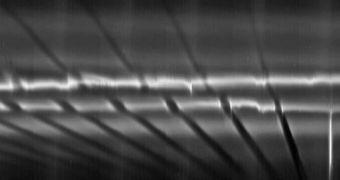A group of investigators has recently presented new evidence that suggest two of Saturn's moons play an important part in creating disturbances in the gas giant's F ring. The structure was discovered only a few decades ago, but it has been undergoing important changes ever since. Researchers have been searching for the source of these events for many years, and now they finally have a lead. They believe that the moon Prometheus, orbiting about 87,000 miles (140,000 kilometers) away from the planet, play an active role in producing snowball-like structures, Space reports.
The ring is an extremely cold structure, and so it stands to reason that it contains a large amounts of ice particles. But the behavior of these particles within the F ring is stranger than that of counterparts in other rings. Due to intense gravitational influences from the giant planet, the small chunks of ice tend to clump up together, forming impressive snowball-like structures. The latest data from the NASA Cassini orbiter seem to indicate that the clumping process is triggered in part by the passing of the moon Prometheus in close proximity to the F ring.
The spacecraft has been conducing such studies of the gas giant since July 1, 2004, when it achieved orbital insertion around the planet. Its instruments are extremely well suited for conducting investigations on the way the gravitational pull of celestial bodies in the Saturn system influences the system as a whole. The planet, its moons and its rings exert tremendous influence on each other, and it's the goal of this mission to make sense of it all. In recent findings, scientists managing Cassini found that, as Prometheus passes by the F ring, it creates channels in its wake, causing small ice particles to start sticking to each other. The connections are triggered by particles' mutual gravitational attraction.
The investigation helps astronomers get even more data on how the solar system first developed after started forming, some 4.6 billion years ago. Planets, asteroids, comets, moons and other structures coalesced from a single source, and experts believe that studying Saturn's F ring may provide the data they are looking for. “Scientists have never seen objects actually form before. We now have direct evidence of that process and the rowdy dance between the moons and bits of space debris,” Carl Murray, a Queen Mary, University of London-based Cassini team member, explains.
He presented the findings on July 20, at the Committee on Space Research meeting in Bremen, Germany. The research was also published in the July 14 online issue of the respected Astrophysical Journal Letters. “The new analysis fills in some blanks in our solar system's history, giving us clues about how it transformed from floating bits of dust to dense bodies. The F ring peels back some of the mystery and continues to surprise us,” adds Cassini project scientist Linda Spilker. She is based at the NASA Jet Propulsion Laboratory (JPL), in Pasadena, California.

 14 DAY TRIAL //
14 DAY TRIAL //